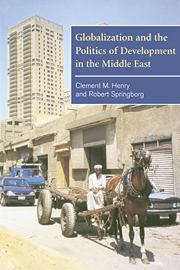Book contents
- Frontmatter
- Contents
- List of figures
- List of tables
- Preface and acknowledgments
- Glossary
- Map. The Middle East and North Africa
- 1 Overview
- 2 The challenges of globalization
- 3 Political capacities and capitalist legacies
- 4 Bunker states
- 5 Bully praetorian states
- 6 Globalizing monarchies
- 7 Fragmented democracies
- 8 Conclusion
- References
- Index
1 - Overview
Published online by Cambridge University Press: 05 June 2012
- Frontmatter
- Contents
- List of figures
- List of tables
- Preface and acknowledgments
- Glossary
- Map. The Middle East and North Africa
- 1 Overview
- 2 The challenges of globalization
- 3 Political capacities and capitalist legacies
- 4 Bunker states
- 5 Bully praetorian states
- 6 Globalizing monarchies
- 7 Fragmented democracies
- 8 Conclusion
- References
- Index
Summary
Some readers may have memories of postwar Alexandria and Cairo or will have read Lawrence Durrell's Alexandria Quartet – the tales of a cosmopolitan high society. Egypt appeared in the mid-1940s to be as economically developed as war-torn Greece and equally ready to catch up with the rest of Europe. To the north, Turkey was singled out like Greece for special assistance under the Truman Doctrine (March 1947) and seemed virtually a part of Europe. To the west, in “French” Algeria, Algiers was at least as prosperous as the rest of France, and, further west, Casablanca was home to big French industrial interests poised to transform the picturesque Moroccan protectorate into Europe's California. At the eastern end of the Mediterranean, a newly independent and polyglot Lebanon was fast becoming the West's principal commercial gateway to Iran, Iraq, and the Gulf. Riding on the postwar oil boom in those states, Lebanon would become the Middle East's Switzerland in the 1950s and 1960s and apparently exemplify an easy “modernization without revolution” (Salem 1973). Beneath snow-covered mountains on the unspoiled shores of a clear and relatively unpolluted Mediterranean Sea, Beirut was as pretty as Geneva in those days, at least in the richer parts of the city, and rather more lively than Calvin's home. Inland, to the east of Lebanon's two mountain ridges, the open Syrian economy boomed with new manufacturing and agricultural development in the 1950s (Sachs and Warner 1995: 34).
- Type
- Chapter
- Information
- Publisher: Cambridge University PressPrint publication year: 2001

